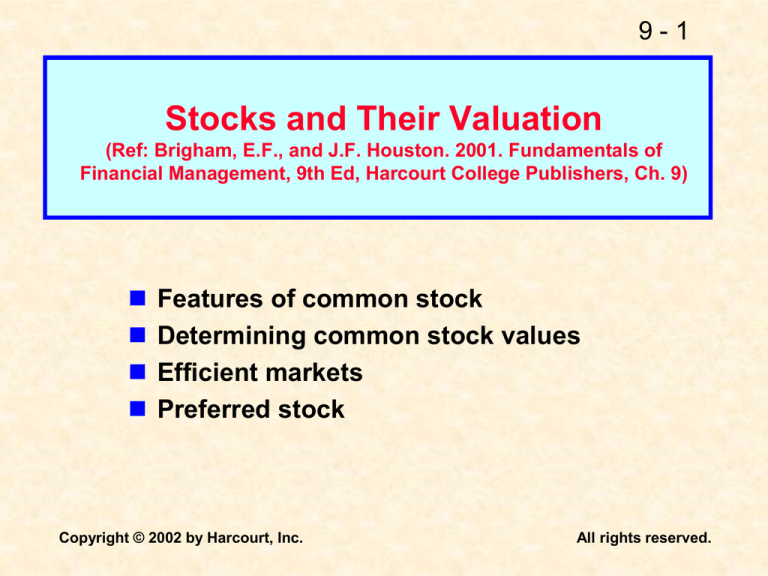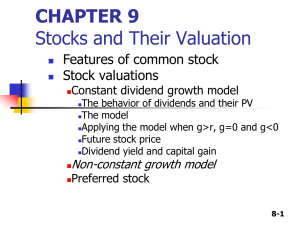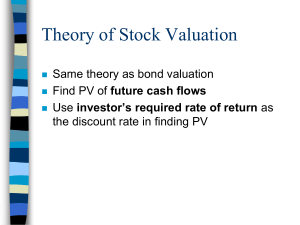
9-1
Stocks and Their Valuation
(Ref: Brigham, E.F., and J.F. Houston. 2001. Fundamentals of
Financial Management, 9th Ed, Harcourt College Publishers, Ch. 9)
Features of common stock
Determining common stock values
Efficient markets
Preferred stock
Copyright © 2002 by Harcourt, Inc.
All rights reserved.
9-2
Facts about Common Stock
Represents ownership.
Ownership implies control.
Stockholders elect directors.
Directors elect management.
Management’s goal: Maximize the
stock price.
Copyright © 2002 by Harcourt, Inc.
All rights reserved.
9-3
Social/Ethical Question
Should management be equally
concerned about employees,
customers, suppliers, and “the
public,” or just the stockholders?
In an enterprise economy,
management should work for
stockholders subject to constraints
(environmental, fair hiring, etc.) and
competition.
Copyright © 2002 by Harcourt, Inc.
All rights reserved.
9-4
When is a stock sale an initial public
offering (IPO)?
A firm “goes public” through
an IPO when the stock is first
offered to the public.
Copyright © 2002 by Harcourt, Inc.
All rights reserved.
9-5
Biggest IPOs of 2000 in the USA
Issuer
Proceeds from sale
AT&T Wireless
$9.03 billion
Infineon Technologies
$2.72 billion
Metropolitan Life Ins. Co.
$2.50 billion
TyCom
$2.88 billion
Genuity
$1.91 billion
Copyright © 2002 by Harcourt, Inc.
All rights reserved.
9-6
Average Initial Returns on IPOs in
Various Countries
100%
75%
50%
25%
Copyright © 2002 by Harcourt, Inc.
All rights reserved.
9-7
Different Approaches for Valuing
Common Stock
1. Dividend growth model:
- Constant Growth (Gordon) Model
- Supernormal (Non-constant) Growth Stock
- Erratic Growth Stock
2. Free cash flow method
3. Using the multiples of comparable
firms
Copyright © 2002 by Harcourt, Inc.
All rights reserved.
9-8
When to use the models?
Constant growth model: most
appropriate for mature companies w
stable history of growth, and stable
future dividends.
Free cash flow method: good for the
large number of companies that don’t
pay a dividend, or for whom it is hard to
forecast dividends.
Copyright © 2002 by Harcourt, Inc.
All rights reserved.
9-9
Definitions of Terms
Dt = Dividend the stockholder expects to
receive at the end of Year t. D0 is the
most recent dividend, which has
already been paid; D1 is the first
dividend expected, and will be paid at
the end of this year; D2 is the dividend
expected at the end of two years, and
so forth. D1 represents the first cash
flow a new purchaser of the stock will
receive. Note that D0, the dividend that
has been paid, is known with certainty.
But all future dividends are expected
values, so the estimate of Dt may differ
among investors.
P0 = Actual market price of the stock today
Copyright © 2002 by Harcourt, Inc.
All rights reserved.
9 - 10
P0 = Expected price of the stock at the end of
Year t (pronounced “P hat t”). P0 is the
intrinsic, or theoretical, value of the stock
today as seen by the particular investor
doing the analysis; P1 is the price
expected at the end of one year; and so
on. Note that P0 is the intrinsic value of
the stock today based on a particular
investor’s estimate of the stock’s
expected dividend stream and the
riskiness of that stream. Hence, whereas
the market price P0 is fixed and is
identical for all investors, P0 could differ
among investors depending on how
optimistic they are about the company.
The caret, or “hat” is used to indicate that
Pt is an estimated value.
cont…
Copyright © 2002 by Harcourt, Inc.
All rights reserved.
9 - 11
cont…
P0, the individual investor’s estimate of
the intrinsic value today, could be above
or below P0, the current stock price, but an
investor would buy the stock only if
his/her estimate of P0 were equal or
greater than P0. Since they are many
investors in the market, there can be many
values for P0. However, we can think of an
“average” or “marginal” investors whose
actions actually determine the market
price. For these marginal investors, P0
must = P0; otherwise a disequilibrium
would exist, and buying and selling in the
market would change P0, until P0 = P0 for
the marginal investor.
Copyright © 2002 by Harcourt, Inc.
All rights reserved.
9 - 12
Market Price, P0 = the price at which
the stock sell in the market
Intrinsic Value, P0 = the value of an
asset that, in the mind of a particular
investor, is justified by the facts; P0
may be different from the asset’s
current market price.
Growth Rate, g = The expected rate of
growth in dividends per share.
Copyright © 2002 by Harcourt, Inc.
All rights reserved.
9 - 13
g = expected growth rate in dividends
as predicted by a marginal investor.
If dividends are expected to grow at a
constant rate, g is also equal to the
expected rate of growth in earnings
and in the stock’s price. Different
investors may use different g’s to
evaluate a firm’s stock, but the
market price, P0, is set on the basis
of the g estimated by marginal
investors.
Copyright © 2002 by Harcourt, Inc.
All rights reserved.
9 - 14
Required Rate of Return, ks = The
minimum rate of return on a common
stock that a stockholder considers
acceptable.
ks = minimum acceptable, or required,
rate of return on the stock,
considering both its riskiness and
the returns available on other
investments. Again, this term
generally relates to marginal
investors. The determinants of ks
include the real rate of return,
expected inflation, and risk.
Copyright © 2002 by Harcourt, Inc.
All rights reserved.
9 - 15
Expected Rate of Return, ks = The rate
of return on a common stock that a
stockholder expects to receive in the
future.
ks = Expected rate of return that an
investor who buys the stock expects
to receive in the future. Ks
(pronounced “k hat s”) could be
above or below ks, but one would
buy the stock only if ks were equal or
greater than ks.
Copyright © 2002 by Harcourt, Inc.
All rights reserved.
9 - 16
Actual, Realized Rate of Return, ks = The
rate of return on a common stock actually
received by stockholders in some past
period. Ks may be greater, or less than,
and/or ks.
ks = actual, or realized, after-the fact rate of
return (pronounce “k bar s”). You may
expect to obtain a return of ks= 15% if you
buy Exxon today, but if the market goes
down, you may end up next year with an
actual realized return that is much lower,
perhaps even negative.
Copyright © 2002 by Harcourt, Inc.
All rights reserved.
9 - 17
Dividend Yield = The expected
dividend divided by the current price
of a share of stock.
D1/P0 = Expected dividend yield on the
stock during the coming year. If the
stock is expected to pay a dividend
of D1 = $1 during the next 12 months,
and its current price is P0 = $10, then
the expected dividend yield is $1/$10
= 0.10 = 10%
Copyright © 2002 by Harcourt, Inc.
All rights reserved.
9 - 18
Capital Gains Yield = The capital gain
during a given year divided by the
beginning price.
(P1-P0)/P0 = Expected capital gains
yield on the stock during the coming
year. If the stock sells for $10 today,
and if it is expected to rise to $10.50
at the end of one year, the expected
capital gain is P1- P0 = $0.50.
Expected capital gain yield =
$0.50/$10 = 5%
Copyright © 2002 by Harcourt, Inc.
All rights reserved.
9 - 19
Expected Total Return = The sum of
the dividend yield and the expected
capital gains yield.
Expected total return = ks = Expected
dividend yield (D1/P0) + expected
capital gains yield (P1-P0)/P0. In our
example, the expected total return is
10% + 5% = 15%
Copyright © 2002 by Harcourt, Inc.
All rights reserved.
9 - 20
Stock Value = PV of Dividends
P 0
D1
D2
D3
1 k 1 k 1 k
1
s
2
s
s
3
. . .
D
1 k
.
s
What is a constant growth stock?
A stock whose dividends are expected to
grow forever at a constant rate, g.
Copyright © 2002 by Harcourt, Inc.
All rights reserved.
9 - 21
For a Constant Growth Stock
D1 = D0(1 + g)1
D2 = D0(1 + g)2 = D1(1+g)1
Dt = D0(1 + g)t
If g is constant, then:
D0(1 + g)
D1
P0 =
=
ks – g
ks – g
^
Copyright © 2002 by Harcourt, Inc.
All rights reserved.
9 - 22
$
Dt D0 1 g
t
Dt
PVD t
t
1 k
0.25
P0 PVD t
0
Copyright © 2002 by Harcourt, Inc.
If g > k, P0 !
Years (t)
All rights reserved.
9 - 23
What happens if g > ks?
D1
ˆ0 =
requires ks > g
P
ks – g
If ks< g, get negative stock price,
which is nonsense.
We can’t use model unless (1) ks > g
and (2) g is expected to be constant
forever.
Copyright © 2002 by Harcourt, Inc.
All rights reserved.
9 - 24
Assume beta = 1.2, kRF = 7%, and kM =
12%. What is the required rate of
return (ks) on the firm’s stock?
Use the SML to calculate ks:
ks= kRF + (kM – kRF) βFirm
= 7% + (12% – 7%) (1.2)
= 13%
Copyright © 2002 by Harcourt, Inc.
All rights reserved.
9 - 25
D0 was $2.00 and g is a constant 6%.
Find the expected dividends for the
next 3 years, and their PVs (ks = 13%)
0
g = 6%
1
D0 = 2.00 2.12
13%
$1.8761
$1.7599
$1.6509
Copyright © 2002 by Harcourt, Inc.
2
2.247
3
2.382
All rights reserved.
9 - 26
What’s the stock’s market value?
D0 = 2.00, ks = 13%, g = 6%
Constant growth model:
D1
$2.12
P0 =
=
ks – g
0.13 – 0.06
=
$2.12
0.07
Copyright © 2002 by Harcourt, Inc.
= $30.29
All rights reserved.
9 - 27
What is the stock’s market value one
^
year from now, P1?
D1 will have been paid, so expected
dividends are D2, D3, D4 and so on.
With P0= $30.29, D2=D1(1+g)=$2.12(1.06)=$2.247;
D2
$2.247
P1 =
=
ks – g
0.13 – 0.06
= $32.10
^
Could also find P1 as follows:
^
P1= P0(1.06)=30.29(1.06)=$32.10
Copyright © 2002 by Harcourt, Inc.
All rights reserved.
9 - 28
Find the expected dividend yield,
capital gains yield, and total return
during the first year.
D1
$2.12
Dividend yld =
=
= 7.0%
P0
$30.29
^
P1 – P0 $32.10 – $30.29
Cap gains yld =
=
$30.29
P0
= 6.0%
Total return = 7.0% + 6.0% = 13.0%
Copyright © 2002 by Harcourt, Inc.
All rights reserved.
9 - 29
Rearrange model to rate of return form:
D
D
1
1
g
P0
to
k
s
k s -– g
P0
^
Then, ks = $2.12/$30.29 + 0.06
= 0.07 + 0.06 = 13%
Copyright © 2002 by Harcourt, Inc.
All rights reserved.
9 - 30
^
What would P0 be if g = 0?
The dividend stream would be a
perpetuity.
0
13%
1
2
3
...
2.00
2.00
2.00
PMT
$2.00
P0 =
=
= $15.38
k
0.13
^
Copyright © 2002 by Harcourt, Inc.
All rights reserved.
9 - 31
If we have supernormal growth of 30%
for 3 years, then a long-run constant
^
g = 6%, what is P0? ks is still 13%.
Can no longer use constant growth
model.
However, growth becomes constant
after 3 years.
Copyright © 2002 by Harcourt, Inc.
All rights reserved.
9 - 32
Valuing a Supernormal/Non-constant
Growth Stock
Supernormal/non-constant growth is that
part of the firm’s life cycle in which it grows
faster than the economy as a whole.
Steps to Value Supernormal Growth Stock:
1. Compute the expected future cash
dividends
cont….
Copyright © 2002 by Harcourt, Inc.
All rights reserved.
9 - 33
2. Compute the stock’s price at a
future point in time, using constant
growth model Pt = Dt+1/(r-g). (You
must pick a point after the dividend
growth rate has become constant)
3. Compute the PV of the expected
future sale price and add that to the
PV of all the expected cash dividends
between now and then.
(Source: Emery, D.R., J.D. Finnerty and
J.D. Stowe.1998. Principles of Financial
Management. Prentice Hall, pp 172-173)
Copyright © 2002 by Harcourt, Inc.
All rights reserved.
9 - 34
Nonconstant growth followed by
constant growth:
0 k = 13% 1
s
g = 30%
D0 = 2.00
2
g = 30%
2.600
3
g = 30%
3.380
4
...
g = 6%...
4.394
4.658
2.301
2.647
3.045
P 3
46.114
54.107
^
= P0
Copyright © 2002 by Harcourt, Inc.
4.658
.
$66.54
0 .13 - 0.06
All rights reserved.
9 - 35
What is the expected dividend yield
and capital gains yield at t = 0?
At t = 4? (Div yield0=Div1/Price)
$2.60
Div. yield0 =
= 4.81%.
$54.11
Cap. gain0 = (ks- div yield)
=13.00% – 4.81% = 8.19%.
Copyright © 2002 by Harcourt, Inc.
All rights reserved.
9 - 36
During nonconstant growth,
dividend yield (D/P) and capital
gains yield are not constant, and
capital gains yield is not equal to g.
After t = 3, g = constant = 6% =
capital gains yield; ks = 13%; so D/P
= 13% – 6% = 7%.
Copyright © 2002 by Harcourt, Inc.
All rights reserved.
9 - 37
Suppose g = 0% for t = 1 to 3, and then
^
g is a constant 6%. What is P0?
0
ks=13%
g = 0%
2.00
1
2
g = 0%
2.00
1.77
1.57
1.39
20.99
25.72
Copyright © 2002 by Harcourt, Inc.
3
g = 0%
2.00
4
g = 6%
2.00
...
2.12
2.12
30.29.
P
3
0.07
All rights reserved.
9 - 38
What is D/P and capital gains yield at
t = 0 and at t = 3?
t = 0:
D1 $2.00
=
= 7.78% (D/P=div yield)
P0 $25.72
CGY = 13% – 7.78% = 5.22%.
t = 3: Now have constant growth
with g = capital gains yield = 6% and
D/P = 7%. (CGY=capital gain yield)
Copyright © 2002 by Harcourt, Inc.
All rights reserved.
9 - 39
What is the annual dividend yield (D/P)
and capital gains yield?
Capital gains yield = g = -6.0%,
Dividend yield= 13.0% – (-6.0%) = 19%.
D/P and cap. gains yield are constant,
with high dividend yield (19%) offsetting
negative capital gains yield.
Copyright © 2002 by Harcourt, Inc.
All rights reserved.
9 - 40
If g = -6%, would anyone buy the
stock? If so, at what price?
Firm still has earnings and still pays
dividends, so P0 > 0:
g
+
D
1
D
0
1
0 =
=
P
-g
-g
ks –
ks –
$2.00(0.94)
$1.88
=
=
= $9.89.
0.13 – (-0.06)
0.19
Copyright © 2002 by Harcourt, Inc.
All rights reserved.
9 - 41
Further Example of Supernormal Growth
Stock
Netscape is operating in a new industry that has
recently caught on with the public. Sales are
growing at 80% per year. This high sales growth
is expected to translate into a 25% growth rate in
cash dividends for each of the next 4 years. After
that, the dividend growth rate is expected to be
5% forever. Annual dividend paid yesterday is
$0.75. The stock’s required return is 22%. What is
Netscape’s stock’s price?
(Source: Emery et al, Principles of Financial Management. 1998.
pp 172-173)
cont….
Copyright © 2002 by Harcourt, Inc.
All rights reserved.
9 - 42
i) Compute the expected future cash dividends:
Time
Div($)
g(%)
0
1
2
3
4
5
6 ...
0.75
0.938
1.172
1.465 1.831
1.923
2.019 …
25%
25%
25%
25%
5%
5%
5% …
ii) Find the stock price at a future time, a point after which the dividend growth rate has
become constant forever. That point is at year 5, thus:
P5 = D6/(r-g) = $2.019/(0.22-0.05) = $11.876
iii) Compute the PVs of all the future expected cash dividends found in step (i)
and add to the PV of the expected future sale price (P5) calculated in step (ii):
P0 = 0.938/1.221 + 1.172/1.222 + 1.465/1.223
+ 1.831/1.224 + 1.923/1.225 + 11.876/1.225
= $(0.768 + 0.787 + 0.807 + 0.827 + 0.711 + 4.394)
= $8.295
Copyright © 2002 by Harcourt, Inc.
All rights reserved.
9 - 43
Valuing An Erratic-Growth Stock (EGS)
Definition: An EGS is a stock which is
expected to have an erratic dividend
growth for some finite time, followed by a
normal rate forever into the future.
P0=D1/( 1+r)1 + D2/(1+r)2 +…Dn/(1+r)n + {(1+g)Dn)/[(1+r)n(r-g)]}
(Source: Emery et al., Principles of Financial Management. 1998.
pp 173-174)
cont…..
Copyright © 2002 by Harcourt, Inc.
All rights reserved.
9 - 44
Example:
Novell’s dividend was $1 last year and is to be $1 for
each of the next 3 years. After its projects have been
developed, earnings are expected to grow at a high rate
for 2 years as sales resulting from new projects are
realized. The higher earnings are expected to result in
40% increase in dividends for 2 years. After these 2
extraordinary increases in dividends, the dividend
growth rate is expected to be 3% per year forever.
Novell’s required rate of return is 12%. What is the worth
of its share today?
(i) First compute the expected future dividends:
Time
0
1
2
3
4
5
6
7 …..
Div($)
1.00
1.00
1.00
1.00
1.40
1.96
2.019
2.079 …
Growth
0%
0%
0%
40%
40%
3%
3%
3% ….
cont…
Copyright © 2002 by Harcourt, Inc.
All rights reserved.
9 - 45
(ii) D5 is where the growth rate in dividends is expected to
become constant forever and is the earliest point that
satisfies the constant-growth assumption. With D5 =$1.96,
g=3%, and r = 12%,
P0 = D1/( 1+r)1 + D2/(1+r)2 +…Dn/(1+r)n + (1+g)Dn/{(1+r)n(r-g)}
P0 = 1.00/1.121
+ 1.00/1.122
+ 1.00/1.123
+1.40/1.124
+ 1.96/1.125
+ (1+0.03)1.96/{(1.12)5(0.12-0.03)}
= $17.13
Copyright © 2002 by Harcourt, Inc.
All rights reserved.
9 - 46
Free Cash Flow Method/Total Company or
Corporate Valuation Model
The free cash flow method suggests
that the value of the entire firm
equals the present value of the firm’s
free cash flows (calculated on an
after-tax basis).
Recall that the free cash flow in any
given year can be calculated as:
NOPAT – Net capital investment
(NOPAT= Net operating profit after taxes)
Copyright © 2002 by Harcourt, Inc.
All rights reserved.
9 - 47
The Corporate Valuation Model (Text,pg 306)
Market Value=Vcompany= PV of expected future Free
cash flows of company
= FCF1/(1+r)1 +FCF2/(1+r)2+…FCFn/(1+r)n
FCF
= (EBIT(1-T) + Dep + Amort)
- (Cap Exp + Change in NOWC);
or
FCF
= NOPAT – New Investment in Operating Cap
Copyright © 2002 by Harcourt, Inc.
All rights reserved.
9 - 48
Using the Free Cash Flow Method
Once the value of the firm is estimated,
an estimate of the stock price can be
found as follows:
MV of common stock (market
capitalization) = MV of firm – MV of
debt and preferred stock.
^
P = MV of common stock/# of shares.
Copyright © 2002 by Harcourt, Inc.
All rights reserved.
9 - 49
Issues Regarding the Free Cash Flow
Method
Free cash flow method is often
preferred to the dividend growth
model -- particularly for the large
number of companies that don’t pay
a dividend, or for whom it is hard to
forecast dividends.
Cont..
Copyright © 2002 by Harcourt, Inc.
All rights reserved.
9 - 50
FCF Method Issues (continued)
Similar to the dividend growth model,
the free cash flow method generally
assumes that at some point in time,
the growth rate in free cash flow will
become constant.
Terminal value represents the value
of the firm at the point in which
growth becomes constant.
Copyright © 2002 by Harcourt, Inc.
All rights reserved.
9 - 51
FCF estimates for the next 3 years are
-$5, $10, and $20 million, after which the FCF is
expected to grow at 6%. The overall firm cost of
capital is 10%.
(r-g = 0.10-0.06 = 0.04)
0
k = 10%
1
2
3
4
g = 6%
-5
-4.545
8.264
15.026
398.197
$416.942
10
20
...
21.20
21.20
$530 =
= *TV3
0.04
*TV3 represents the terminal value of
the firm, at t = 3
Copyright © 2002 by Harcourt, Inc.
All rights reserved.
9 - 52
If the firm has $40 million in debt and
has 10 million shares of stock, what is
the price per share?
Value of equity = Total value – Value of debt
= $416.94 – $40
= $376.94 million
Price per share = Value of equity/# of shares
= $376.94/10
= $37.69
Copyright © 2002 by Harcourt, Inc.
All rights reserved.
9 - 53
Using the Multiples of Comparable
Firms to Estimate Stock Price
Analysts often use the following multiples
to value stocks:
P/E
P/CF
P/Sales
P/Customer
Example: Based on comparable firms,
estimate the appropriate P/E. Multiply this
by expected earnings to back out an
estimate of the stock price.
Copyright © 2002 by Harcourt, Inc.
All rights reserved.
9 - 54
What is market equilibrium?(Text,pg310-312)
In equilibrium, stock prices are stable.
There is no general tendency for
people to buy versus to sell.
In equilibrium, expected returns must
equal required returns:
^
ks = (D1/P0) + g = ks = kRF + (kM – kRF)βfirm
Copyright © 2002 by Harcourt, Inc.
All rights reserved.
9 - 55
Expected returns are obtained by
estimating dividends and expected capital
gains (which can be found using any of the
three common stock valuation approaches).
^
Ks = (D1/P0) + g
Required returns are obtained from the
CAPM:
ks = kRF + (kM – kRF)βfirm
Copyright © 2002 by Harcourt, Inc.
All rights reserved.
9 - 56
How is equilibrium established?
If k^s = D1 + g > ks (CAPM) then
P0
P0 is “too low” (a bargain).
Buy orders > sell orders;
P0 bid up; D1/P0 falls until
(D1/P0) + g = k^s = ks
Copyright © 2002 by Harcourt, Inc.
All rights reserved.
9 - 57
Why do stock prices change?
D1
P0 =
.
ki – g
^
1. ki could change:
ki = kRF + (kM – kRF )bi.
kRF = k* + IP.
2. g could change due to
economic or firm situation.
Copyright © 2002 by Harcourt, Inc.
All rights reserved.
9 - 58
What’s the Efficient Market Hypothesis
(EMH)?
EMH: Securities are normally in
equilibrium and are “fairly priced.”
One cannot “beat the market”
except through good luck or better
information.
Copyright © 2002 by Harcourt, Inc.
All rights reserved.
9 - 59
1. Weak-form EMH:
Can’t profit by looking at past
trends. A recent decline is no
reason to think stocks will go up
(or down) in the future.
Evidence supports weak-form
EMH, but “technical analysis” is
still used.
Copyright © 2002 by Harcourt, Inc.
All rights reserved.
9 - 60
2. Semistrong-form EMH:
All publicly available
information is reflected in
stock prices, so doesn’t pay to
pore over annual reports
looking for undervalued
stocks. Largely true, but
superior analysts can still
profit by finding and using new
information.
Copyright © 2002 by Harcourt, Inc.
All rights reserved.
9 - 61
3. Strong-form EMH:
All information, even inside
information, is embedded in
stock prices. Not true--insiders
can gain by trading on the basis
of insider information, but that’s
illegal.
Copyright © 2002 by Harcourt, Inc.
All rights reserved.
9 - 62
Markets are generally efficient
because:
1. 15,000 or so trained analysts; MBAs,
CFAs, Technical PhDs.
2. Work for firms like Merrill, Morgan,
Prudential, which have a lot of money.
3. Have similar access to data.
4. Thus, news is reflected in P0 almost
instantaneously.
Copyright © 2002 by Harcourt, Inc.
All rights reserved.
9 - 63
Preferred Stock
Hybrid security.
Similar to bonds in that preferred
stockholders receive a fixed dividend
that must be paid before dividends can
be paid on common stock.
However, unlike interest payments on
bonds, companies can omit dividend
payments on preferred stock without
fear of pushing the firm into bankruptcy.
Copyright © 2002 by Harcourt, Inc.
All rights reserved.
9 - 64
What’s the expected return of
preferred stock with Vp = $50 and
annual dividend = $5?
$5
Vp $50
.
kp
ˆkp $5 0.10 10.0%.
$50
Copyright © 2002 by Harcourt, Inc.
All rights reserved.










